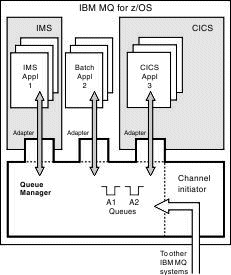![[z/OS]](ngzos.gif)
The queue manager on z/OS
Before you can let your application programs use IBM® MQ on your z/OS® system, you must install the IBM MQ for z/OS product and start a queue manager. The queue manager owns and manages the set of resources that are used by IBM MQ.
The queue manager
A queue manager is a program that provides messaging services to applications. Applications that use the Message Queue Interface (MQI) can put messages on queues and get messages from queues. The queue manager ensures that messages are sent to the correct queue or are routed to another queue manager. The queue manager processes both the MQI calls that are issued to it, and the commands that are submitted to it (from whatever source). The queue manager generates the appropriate completion codes for each call or command.
- Page sets that hold the IBM MQ object definitions and message data
- Logs that are used to recover messages and objects in the event of queue manager failure
- Processor storage
- Connections through which different application environments ( CICS®, IMS, and Batch) can access the IBM MQ API
- The IBM MQ channel initiator, which allows communication between IBM MQ on your z/OS system and other systems
The queue manager has a name, and applications can connect to it using this name.
Figure 1 illustrates a queue manager, showing connections to different application environments, and the channel initiator.

The queue manager subsystem on z/OS
On z/OS, IBM MQ runs as a z/OS subsystem that is started at IPL time. In the subsystem, the queue manager is started by executing a JCL procedure that specifies the z/OS data sets that contain information about the logs, and that hold object definitions and message data (the page sets). The subsystem and the queue manager have the same name, of up to four characters. All queue managers in your network must have unique names, even if they are on different systems, sysplexes, or platforms.